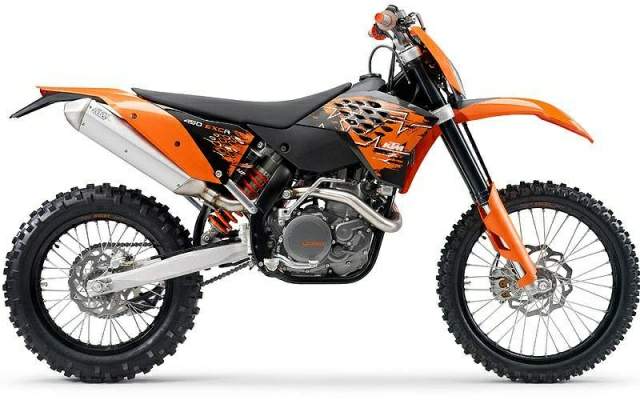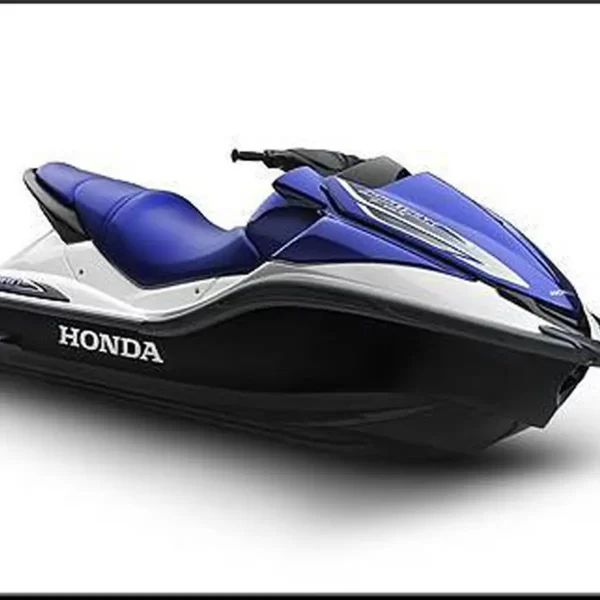
KTM EXC / SX, model year 2008
To remember the beginning of the EXC series that dominated the enduro world, there is no need to look back. It was 1999 when KTM introduced a new gadget for enduro and motocross racing bikes with the recently purchased Husaberg. Today, every motorsport enthusiast knows the orange-colored success story.
But times are changing, and with them (especially) environmental requirements. The old and tried-and-true unit had to say goodbye and the new XC4 now meets Euro3 standards with an exhaust system that also has a catalytic converter.
After last year's completely revamped motocross lineup and a new engine for the SX-F models with dual overhead camshafts, the most common question was whether KTM could simply fit a quieter exhaust and mandatory enduro equipment (front and rear lights). existing model range of motocross., meters ...). But that did not happen.
The motocross and enduro models now really share a frame, some plastic parts and a swingarm, and that's it. The engine is now only available in two sizes - 449 cc. CM with bore and stroke 3×63mm and 4cc. See from 95 × 510 mm. Both are created and developed only for the needs of enduro riders.
At the head of the new unit there is only one camshaft with four titanium valves each, which reduces the aggressiveness required for motocross. The cylinder head itself also has a new oblique cut for quicker access and easier valve adjustment. There is also a difference in the main shaft, lubrication and transmission. The shaft is heavier due to the need for better grip on the rear wheel (inertia), but they did not forget about the comfort and added a counterweight shaft to dampen vibrations. The oil for the gearbox and the cylinder is the same, but in two separate chambers and three pumps take care of the flow. The gearbox is of course a typical six-speed enduro. The device has become half a kilogram lighter.
Other innovations in the four-stroke enduro models are: a larger airbox that allows the replacement of the air filter (Twin-Air as standard) without the use of tools, a new fuel tank for good traction. knees and bayonet fuel cap (also on SX models), front grille with headlights is lighter, more scratch and impact resistant and in line with home design guidelines, rear fender and side panels are modeled last In last year's SX models, the taillight (LEDs ) smaller, the new and the side coolers with embossed graphics are lighter, the exhaust system in accordance with the EURO III standard has a more modern design, the side step is new, the cooling is more efficient and therefore less unsprung weight, the EXCEL discs are lighter.
Also new is the PDS rear shock with ten millimeters of travel and a more progressive damping curve. A swingarm that, when combined with a cromolybdenum oval tube frame, provides the required rigidity and flexibility to make the job easier. so that the motorcycle "breathes" with the driver and the terrain.
The 250cc EXC-F has also undergone some changes in the cylinder head and ignition curve, so its responsiveness at low revs is now better.
The two-stroke ruler has undergone minor adjustments. The piston in the EXC and SX 125 models is new, the intake ports have been optimized for more power in low mode, and all two-stroke engines also have two ignition curves for different driving conditions. A big novelty in the EXC 300 is the standard electric starter (optional on the EXC 250), the new cylinder is XNUMX kilograms lighter.
Note the even stronger grip on the SX-F 450 (better oil flow). In the field, the innovations have proven themselves well. We were particularly impressed with the EXC-R 450, which is better for its class than its predecessor (and this one was not bad). The driving experience has become easier and above all, we couldn't help but admire the engine, which is perfect for enduro conditions. It does not run out of power, neither below nor when pushing, and at the same time, it works with such torque that climbing steep and rocky slopes is not too tiring.
The ergonomics are perfect and the new fuel tank does not interfere with the motorcycle. The brakes worked great, they are still at their best in terms of power, and progress is felt in the suspension. Only a slight nose-off from cornering (most noticeable in off-road tests) and a suspension that kept the driver out of the way at full throttle separated this KTM from perfection.
The KTM is still reluctant to shake on rough terrain under high acceleration, and the rear bounces hard. It is true, however, that PDS performs better than the classic crank system in some cases (especially on sand and flat surfaces). We also find good solutions that, in the spirit of minimalism, perfectly fulfill the mission of competitive enduro. This way you won't find unnecessary junk, huge switches or fragile tools on it. I would like to praise the durable Renthal bar without the crossbar and the solid bar that did not break despite our awkwardness and stepping.
The big brother with the EXC-R 530 designation is a little more difficult to drive and requires a well-trained driver, mainly due to the greater inertia of the rotating masses. Progress has also been made with the EXC-F 250, which, in addition to the frame, plastic body and suspension, has gained flexibility and an extended engine operating range.
An interesting and special story is the EXC 300 E, that is, a two-stroke with an electric starter. KTM still believes in and develops two-stroke engines (they also meet EURO III standards) that will appeal best to amateur riders who value affordability and less maintenance, as well as all extremists who need to climb impossible directions as easily as possible. but with minimal load. at the same time a powerful engine. Here, KTM has a really rich palette that you can choose to your liking and you can never miss it. Of the EXCs with 200, 250 and 300cc engines, three hundred are the ones to like the most.
Finally, a word of surprise from the SX family of motocross models. As stated, KTM notes that two-stroke engines are not a thing of the past, which is why they were the first to officially unveil the 144cc two-stroke engine. See (SX 144), which will try to compete with the 250cc four-stroke engines. some countries. It is a larger 125 cubic meter unit that is indeed less demanding to drive than the 125 SX, but has no real capabilities compared to the four-stroke engine in the same house.
We even wonder if an amateur racer on a 250cc two-stroke engine can do it. See overtaking a four-stroke engine with the same displacement but significantly fewer horses? Probably not. Sorry. But as rumors spread of the return of the two-stroke engine (125cc) to the World Championship (MX2 class), there remains hope, especially for motocross and youth looking to race. Also because of KTM, who obviously understands the importance of offspring well. Last but not least, for young people, their SX 50, 65 and 85 are already true race cars, replicas of these big race cars.
KTM 450 EXC-R
Test car price: 8.500 EUR
engine: single cylinder, four stroke, 449, 3 cm3, 6 gears, carburetor.
Frame, suspension: Oval Cro-Moly tubes, cast aluminum swingarm, 48mm front fork, PDS single adjustable rear damper.
brakes: diameter of the front reel 260 mm, rear 220 mm.
Wheelbase: 1.481 mm
Fuel tank: 9 l.
Seat height from ground: 925 mm
Weight: 113, 9 kg, without fuel
dinner: 8.500 euro
Contact person: www.hmc-habat.si, www.axle.si
Praise and criticize (common to all models)
+ engine (450, 300-E)
+ ergonomics
+ high-quality manufacturing and components
+ air filter access, easy maintenance
+ front suspension (also excellent plastic protection)
+ quality plastic parts
+ gas tank cap
+ design innovation
- worry at high speeds over bumps
- does not have standard crankcase protection
- squeezing the nose out from under the bend (EXC models)
Peter Kavcic, photo: Herwig Poiker in Harry Freeman
Basic data
Base model price: € 8.500 XNUMX
Test model cost: € 8.500 XNUMX €
Technical information
engine: single cylinder, four stroke, 449,3 cm3, 6 gears, carburetor.
Frame: Oval Cro-Moly tubes, cast aluminum swingarm, 48mm front fork, PDS single adjustable rear damper.
brakes: diameter of the front reel 260 mm, rear 220 mm.
Fuel tank: 9 l.
Wheelbase: 1.481 mm
Weight: 113,9 kg, without fuel

